
The main St Joseph’s Seminary building of 1866
This article was published previously in Saigoneer http://saigoneer.com
One of the first Roman Catholic institutions founded by Bishop Dominique Lefèbvre following the French conquest of 1859, the rarely-visited St Joseph’s Seminary offers a unique oasis of calm in a busy city.
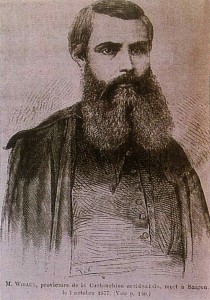
The founder of St Joseph’s Seminary, Father Louis Théodore Wibaux (1820-1878)
Saigon’s first seminary for the training of Roman Catholic priests was established in around 1850 by Monsignor, later Bishop Dominique Lefèbvre of the Christian Brothers (Frères des écoles chrétiennes), next to the Thị Nghè creek at Phú Mỹ. However in July 1858, during the preliminary French campaign in Đà Nẵng, its director, Father Phaolô Lê Văn Lộc, was arrested by royal troops and beheaded on the Trường Thi examination field outside the Gia Định Citadel.
Lộc’s successor, Father Louis Théodore Wibaux (1820-1878), arrived in Saigon in January 1860. In addition to placing him in charge of the Phú Mỹ Seminary, Lefèbvre also appointed him as Provicar General of the Diocese. Once in Saigon, Wibaux is said to have “constantly busied himself training young students of the sanctuary, as he had done previously in France for nearly 15 years before devoting himself to the foreign missions.”
Two years later, during the final stages of the French conquest of Cochinchina, the old Phú Mỹ Seminary was burned to the ground, so Father Wibaux was sent out to find land on which to build a new one. Arriving at a large open field near the near the naval shipyard on boulevard de la Citadelle (Tôn Đức Thắng street), he is reported to have said: “Hie est Locus (This is the place).”
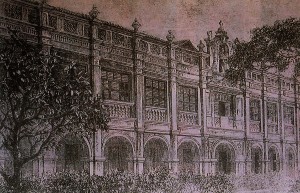
An engraving of the St Joseph’s Seminary building of 1866
Bishop Dominique Lefèbvre subsequently decided to settle several different religious institutions on the site selected by Father Wibaux, and on 28 August 1862, the French authorities granted a 14,400m² plot of land to the Christian Brothers for construction of the new St Joseph’s Seminary and an adjacent 10,800m² plot to the Congregation of the Sisters of Saint-Paul de Chartres for the construction of a Sainte-Enfance or “Holy Childhood” orphanage for local street children.
The foundation stone of the Seminary was laid in 1863 by Bishop Lefèbvre, and in 1863-1866 Father Wibaux oversaw the construction of the first Seminary building. Because “at this time the resources of the mission were not significant,” construction took several years. Measuring 45m long and 21m wide, with a wide verandah surrounding all four sides, the Seminary building was completed in 1866, “thanks to the zeal and generosity of Father Wibaux, who dedicated to this work the greater part of his personal fortune.” It was inaugurated in 1866 by Lefèbvre’s successor, Bishop Miche.
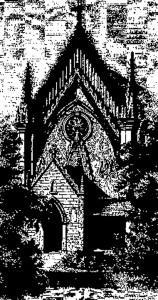
An engraving of the St Joseph’s Seminary Chapel of 1871
In the early days of the new Seminary, a large inner hall was used for worship, but in 1867, Father Wibaux began work on a dedicated new chapel. Located immediately behind the Seminary and measuring “30m long by 10m wide, with a vault height of 10m,” the Seminary Chapel was inaugurated by Bishop Miche on 19 April 1871.
When Father Wibaux died on 7 October 1877, “leaving the seminar in a very satisfactory state of prosperity,” he was interred behind the Seminary Chapel. In 1913, a mausoleum was raised around his tomb.
At the time of its inauguration in 1866, the Seminary had just seven teachers and 60 students, but in subsequent years the intake and number of teaching staff increased steadily. By the 1920s, its activities had outgrown its facilities, so in 1928-1932, two new wings were added, permitting the Seminary to be divided into a Grand Seminaire for senior students and a Petit Seminaire for junior students.
During the Allied bombing campaign of 1943-1944, the Seminary was evacuated to temporary facilities in Lái Thiêu, Vĩnh Long and Cái Nhum. It resumed operations in mid-1946, and during the subsequent Indochina Wars the Seminary buildings escaped major damage.
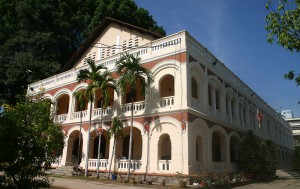
A side view of the main St Joseph’s Seminary building
After Reunification, the St Joseph’s Seminary continued to function until 1982, when it temporarily ceased operations pending reorganisation. It reopened in 1987 without the Petit Seminaire.
Today, the original 1866 Seminary building still stands at the centre of the compound. Extensively restored in the period 1998-2005 and refurbished again in 1914, it houses the main offices of the centre, a library, a small Heritage Centre (Nhà truyền thống) and an exhibition gallery.
The Heritage Centre comprises two rooms situated either side of the central corridor at the rear of the building. Here visitors will find a valuable collection of religious artefacts, including devotional statues, altar accessories (crucifixes, candlestick holders and candelabra, water and wine cruets, finger basins, bells, altar linens etc), an ornate 19th-century platform once used to carry devotional statues in street processions, antique furniture (tables, cabinets and screens) made from precious wood and featuring exquisite engraving and mother-of-pearl inlay, religious artefacts made from Biên Hòa ceramics, parallel sentences and two old church organs.
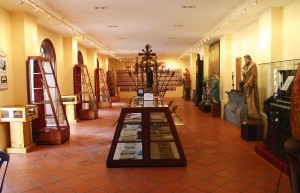
One of two rooms which comprise the St Joseph’s Seminary Heritage Centre
Here, too, is a display of ceremonial regalia which once belonged to Archbishop Phaolô Nguyễn Văn Bình (1960–1995), including robes, pectoral cross, ring, mitre, crozier (staff) and pallium, plus books and other personal items. The Heritage Centre also contains a valuable collection of old religious books and documents, including devotional literature in Hán-Nôm and Bishop Pigneau de Behaine’s Dictionarium Anamitico-Latinum (1838), as well as printing artefacts from the Imprimerie Tan-Dinh or “Imprimerie de la Mission” at Tân Định Church (see last week’s Old Saigon Building of the Week).
On the upper floor there are two small exhibition galleries which display mainly religious art works from the personal collection of the late Father Dominique Trần Thái Hiệp (1926-1992). These include paintings and drawings by many leading southern artists from both before and after Reunification, including Lê Văn Đệ, Tạ Tỵ, Duy Thanh, Ngọc Dũng, Thái Tuấn, Nguyễn Siên, Văn Đen, Nguyễn Văn Rô, Nguyễn Anh, Nguyễn Thương, Lê Văn Bình, Tố Phượng and Tố Oanh.
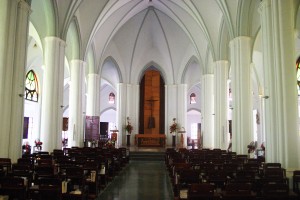
The interior of the St Joseph’s Seminary Chapel
Immediately behind the main building, across a peaceful tree-lined courtyard, lies the Seminary Chapel, the Gothic edifice inaugurated by Bishop Miche in 1871. The Chapel comprises a central vaulted nave flanked by vaulted aisles and flat-roofed side corridors. The aisles extend around the back of the altar platform as an ambulatory and their outer aisle pillars are hung with the 14 Stations of the Cross. The wooden crucifix panel on the rear wall of the altar platform is a fairly recent addition.
Immediately behind it is the tomb of the Seminary’s founder, Father Louis Théodore Wibaux, housed in the ornate mausoleum of 1913.
Getting there
Address: Trung tâm Văn hóa Công Giáo Thành Phố Hồ Chí Minh – Đại Chủng viện Thánh Giuse, 6 Tôn Đức Thắng, Phường Bến Nghé, Quận 1, Thành Phố Hồ Chí Minh
Telephone: 84 (0) 90 724 2678 (Father Nguyễn Duy, Administration, Vietnamese language only)
Opening hours: On request 8.15am-11am, 2pm-4pm daily
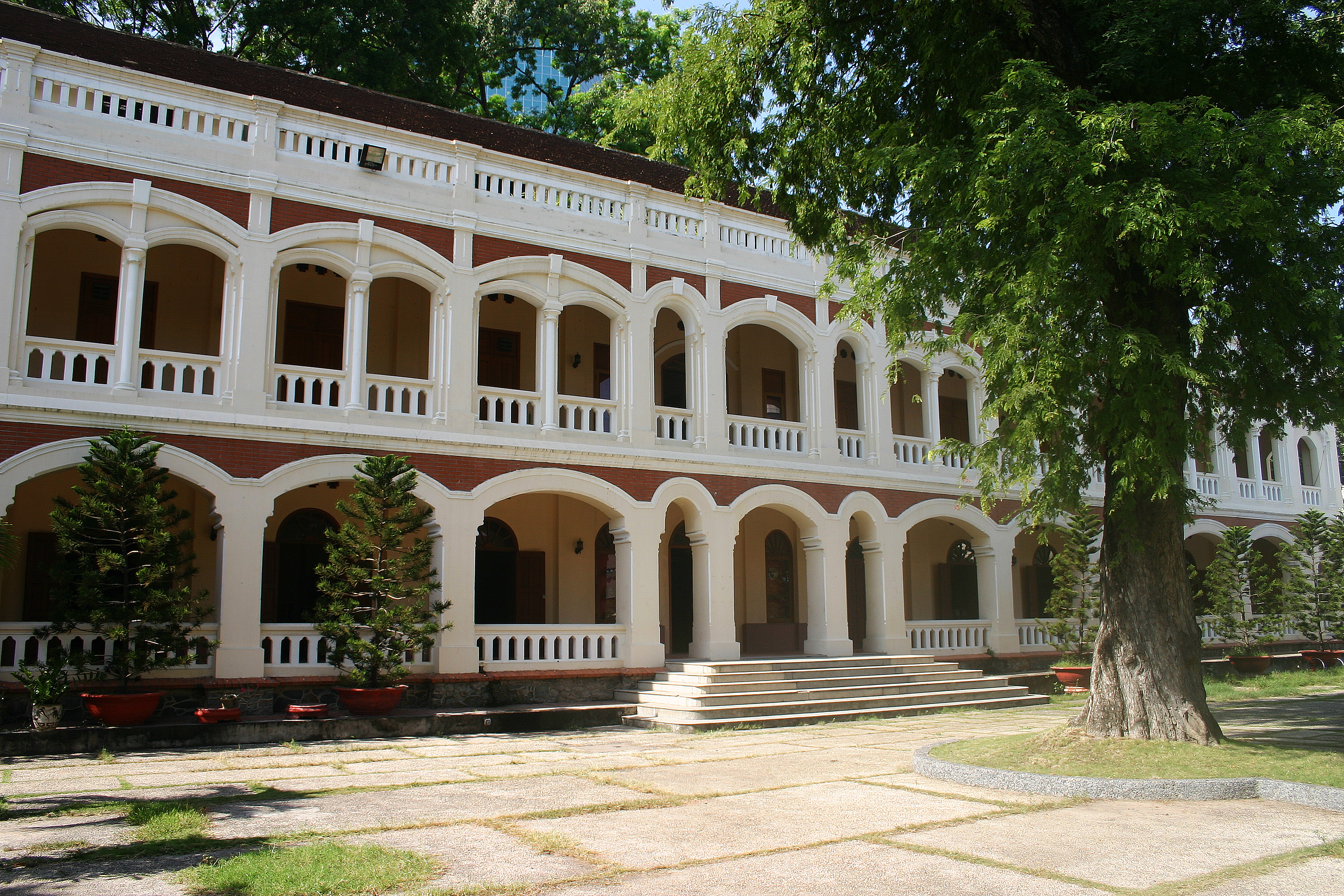
Another view of the main St Joseph’s Seminary building

The facade of the St Joseph’s Seminary Chapel

The mausoleum of Father Louis Théodore Wibaux (1820-1878)

The tomb of Father Louis Théodore Wibaux (1820-1878)
Tim Doling is the author of the guidebook Exploring Saigon-Chợ Lớn – Vanishing heritage of Hồ Chí Minh City (Nhà Xuất Bản Thế Giới, Hà Nội, 2019)
A full index of all Tim’s blog articles since November 2013 is now available here.
Join the Facebook group pages Saigon-Chợ Lớn Then & Now to see historic photographs juxtaposed with new ones taken in the same locations, and Đài Quan sát Di sản Sài Gòn – Saigon Heritage Observatory for up-to-date information on conservation issues in Saigon and Chợ Lớn.


Beautiful edifice. I need to visit one day. Thank you Tim.